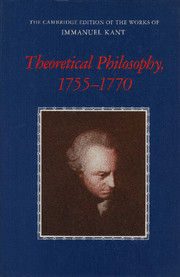Book contents
- Frontmatter
- Contents
- General editors' preface
- Preface
- Guide to abbreviations
- General introduction
- Introductions to the translations
- Résumés of the works
- A NEW ELUCIDATION OF THE FIRST PRINCIPLES OF METAPHYSICAL COGNITION (1755)
- THE EMPLOYMENT IN NATURAL PHILOSOPHY OF METAPHYSICS COMBINED WITH GEOMETRY, OF WHICH SAMPLE I CONTAINS THE PHYSICAL MONADOLOGY (1756)
- AN ATTEMPT AT SOME REFLECTIONS ON OPTIMISM (1759)
- THE FALSE SUBTLETY OF THE FOUR SYLLOGISTIC FIGURES (1762)
- THE ONLY POSSIBLE ARGUMENT IN SUPPORT OF A DEMONSTRATION OF THE EXISTENCE OF GOD (1763)
- ATTEMPT TO INTRODUCE THE CONCEPT OF NEGATIVE MAGNITUDES INTO PHILOSOPHY (1763)
- Preface
- Section 1 Elucidation of the concept of negative magnitudes in general
- Section 2 In which philosophical examples embodying the concept of negative magnitudes are adduced
- Section 3 Containing some reflections which may serve to prepare the application of the above concept to the objects of philosophy
- INQUIRY CONCERNING THE DISTINCTNESS OF THE PRINCIPLES OF NATURAL THEOLOGY AND MORALITY (1764)
- M. IMMANUEL KANT'S ANNOUNCEMENT OF THE PROGRAMME OF HIS LECTURES FOR THE WINTER SEMESTER 1765 — 1766 (1765)
- DREAMS OF A SPIRIT-SEER ELUCIDATED BY DREAMS OF METAPHYSICS (1766)
- CONCERNING THE ULTIMATE GROUND OF THE DIFFERENTIATION OF DIRECTIONS IN SPACE (1768)
- ON THE FORM AND PRINCIPLES OF THE SENSIBLE AND THE INTELLIGIBLE WORLD [INAUGURAL DISSERTATION] (1770)
- Factual notes
- Bibliographies of editions and translations
- Glossary
- Biographical-bibliographical sketches of persons mentioned by Kant
- Index
Section 1 - Elucidation of the concept of negative magnitudes in general
Published online by Cambridge University Press: 18 December 2014
- Frontmatter
- Contents
- General editors' preface
- Preface
- Guide to abbreviations
- General introduction
- Introductions to the translations
- Résumés of the works
- A NEW ELUCIDATION OF THE FIRST PRINCIPLES OF METAPHYSICAL COGNITION (1755)
- THE EMPLOYMENT IN NATURAL PHILOSOPHY OF METAPHYSICS COMBINED WITH GEOMETRY, OF WHICH SAMPLE I CONTAINS THE PHYSICAL MONADOLOGY (1756)
- AN ATTEMPT AT SOME REFLECTIONS ON OPTIMISM (1759)
- THE FALSE SUBTLETY OF THE FOUR SYLLOGISTIC FIGURES (1762)
- THE ONLY POSSIBLE ARGUMENT IN SUPPORT OF A DEMONSTRATION OF THE EXISTENCE OF GOD (1763)
- ATTEMPT TO INTRODUCE THE CONCEPT OF NEGATIVE MAGNITUDES INTO PHILOSOPHY (1763)
- Preface
- Section 1 Elucidation of the concept of negative magnitudes in general
- Section 2 In which philosophical examples embodying the concept of negative magnitudes are adduced
- Section 3 Containing some reflections which may serve to prepare the application of the above concept to the objects of philosophy
- INQUIRY CONCERNING THE DISTINCTNESS OF THE PRINCIPLES OF NATURAL THEOLOGY AND MORALITY (1764)
- M. IMMANUEL KANT'S ANNOUNCEMENT OF THE PROGRAMME OF HIS LECTURES FOR THE WINTER SEMESTER 1765 — 1766 (1765)
- DREAMS OF A SPIRIT-SEER ELUCIDATED BY DREAMS OF METAPHYSICS (1766)
- CONCERNING THE ULTIMATE GROUND OF THE DIFFERENTIATION OF DIRECTIONS IN SPACE (1768)
- ON THE FORM AND PRINCIPLES OF THE SENSIBLE AND THE INTELLIGIBLE WORLD [INAUGURAL DISSERTATION] (1770)
- Factual notes
- Bibliographies of editions and translations
- Glossary
- Biographical-bibliographical sketches of persons mentioned by Kant
- Index
Summary
Two things are opposed to each other if one thing cancels that which is posited by the other. This opposition is two-fold: it is either logical through contradiction, or it is real, that is to say, without contradiction.
The first opposition, namely logical opposition, is that upon which attention has been exclusively and uniquely concentrated until now. The opposition consists in the fact that something is simultaneously affirmed and denied of the very same thing. The consequence of the logical conjunction is nothing at all (nihil negativum irrepraesentabile), as the law of contradiction asserts. A body which is in motion is something; a body which is not in motion is also something (cogitabile); but a body which is both in motion and also, in the very same sense, not in motion, is nothing at all.
The second opposition, namely real opposition, is that where two predicates of a thing are opposed to each other, but not through the law of contradiction. Here, too, one thing cancels that which is posited by the other; but the consequence is something (cogitabile). The motive force of a body in one direction and an equal tendency of the same body in the opposite direction do not contradict each other; as predicates, they are simultaneously possible in one body. The consequence of such an opposition is rest, which is something (repraesentabile). It is, nonetheless, a true opposition. For that which is posited by the one tendency, construed as existing on its own, is cancelled by the other tendency, and the two tendencies are true predicates of one and the self-same thing, and they belong to it simultaneously. The consequence of the opposition is also nothing, but nothing in another sense to that in which it occurs in a contradiction (nihil privativum, repraesentabile). We shall, in future, call this nothing: zero = 0. Its meaning is the same as that of negation (negatio), lack, absence – notions which are in general use among philosophers – albeit with a more precise determination which will be specified later on.
- Type
- Chapter
- Information
- Theoretical Philosophy, 1755–1770 , pp. 211 - 217Publisher: Cambridge University PressPrint publication year: 1992

